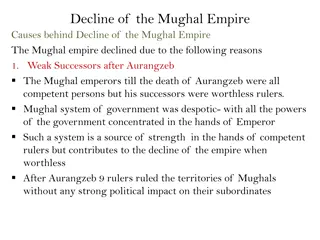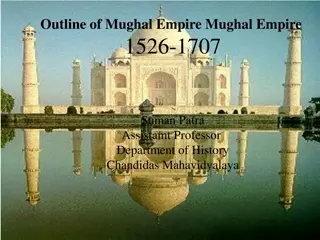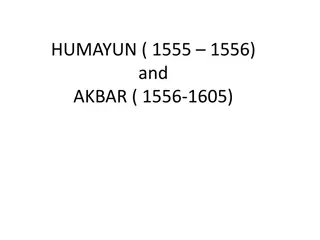The Rise of New States and Hindu Principalities in Decline of the Mughal Empire
During the later Mughal period, provincial governors gained independence, laying the foundation for new dynasties in regions like Oudh, Bengal, and South. The rise of Hindu states, including Rajputs and Sikhs, contributed to the disintegration of the Mughal Empire. Governors like Saadat Khan Burhan-ul-Mulk of Oudh and Murshid Quli Khan of Bengal established autonomous states. The Sikhs, led by Banda Bahadur and later Ranjit Singh, rose to prominence through military conquests. This marked a significant shift in power dynamics within the Indian subcontinent.
Download Presentation

Please find below an Image/Link to download the presentation.
The content on the website is provided AS IS for your information and personal use only. It may not be sold, licensed, or shared on other websites without obtaining consent from the author. Download presentation by click this link. If you encounter any issues during the download, it is possible that the publisher has removed the file from their server.
E N D
Presentation Transcript
Rise of New States Introduction Mughal Rulers always inspected the administration of provincial governors.- they also inspected their accounts concerning the income and expenditure of the state. But during the Later Mughals the central authority became weakened, the emperors lost control over the governors Consequently the provincial governors assumed independence, they freed themselves from the central authority They accepted the suzerainty of the Mughal King, but for intents and purposes they were independent. These provincial governors thus laid the foundation of independent dynasties. The most prominent amongst them were the governors of Oudh, Bengal and South.
Rise of Oudh The province of the Oudh comprised Banaras, Allahabhad and Kanpur Saadat Khan Burhan-ul- Mulk Founder of Oudh as autonomous state in 1722- after him Safdar Jung appointed as Wazir since Safdar and his successors were called as Nawab Wazirs Most wealthiest independent state in Mughul Empire Wazid Ali Shah was the last Nawab of Awadh it was annexed by Lord Dalhousie in Feb 1856- pensioned off and deported to Calcutta.
Rise of Bengal In 1700 Aurangzeb appointed Murshid Quli Khan as Bengal s Diwan after the death of Aurangzeb, he transferred his capital from Dcaca to Murshidabad. He also endowed with the Governorship of Orissa in 1727, in 1733 Bihar was added Bengal State. During his tenure many reforms in finance and reorganization of administration were given importance. He followed by Shuja- Ud- din, Sarfaraz Khan, Alivardi Khan, Siraj-ud-duala Rise of Deccan Another state which assumed independence was that of South. Nizam ul- Mulk Asaf Jah founder of Hyderbad state Under him Deccan became completely free from authority of Mughul kings.- prominent Nizam- Nasir Jung, Muzaffar Jung, Salabat Jung
Rise of Hindu States Introduction Political awakening among the Hindu Martial classes also contributed to the disintegration of the Mughal Empire Rajput's in Rajasthan, Sikhs in Punjab, Jats in Agra and Mathura and Marathas in Maharastra. These classes made an attempt to establish a separate independent principalities. They rose to eminence on the ruins of the Mughal Empire. 1. Rise of Rajputs After the death of Aurangzeb the Rajput chiefs of Mewar, Marwar and Amber formed a confederacy in 1708 After the death of Bahadur Shah, Rajputs became practically independent.
2. Rise of Sikhs After the death of Last and tenth Sikh guru Govind Singh in 1708, the political and military leadership of the Sikhs came into the hands of Banda Bahadur.- He defeated and killed Wazir Khan , the Mughul Governor During the reign of Ranjit Singh Sikh attained the zeinth through his military expedition and diplomatic move. He captured Lahore and Amirstar in 1802 he added the Golden dome to the Golden Temple- he started the westernization of Sikh Army with the help of Europeans- Ranjit Singh appointed ablest Hindus Muslims and even Europeans in his administration notable Europeans was Avitabile- appointed as Governor in his reign- Traty of Amirstar was signed with Britishers in 1809
3. Rise of Jats After the death of Aurangzeb Jats under the Leader Chauramal Jat took full advantage of the weakness of the Mugul empire and extended their control- took control over Mathura and Agra district- Badhan Singh continued the expansion policy of Jats by plundering the Mughul empire He made Bharatpur as capital of Jats- after the Third Battle of Panipet- they started to dwindle in the political field. 4. Rise of Marathas The period from 1707 to 1761 Marathas under Peshwas rose to the political prominence by invading and capturing the parts of Mughul Empire. In 1719 Balaji Viswanath-gained the charging Chauth tax from six provinces of Mughul empire Under Balaji Baji Rao marathas were at the apex of their power
5.Rise of Carnatic Foundation of this autonomous state by Saadutullah Khan with Arcot as its capital in 1720s. He was nominally under the control of the Nizam of Hyderabad Chanda Shaib came to the throne by murdering Anwar- ud-din in 1749 with the help of the French Lord Welleslyey pensioned off the last Nawab of Carnatic in 1801. 6.Rise of Mysore Mysore state became independent under the Hindu Wodeyar Dynasty in 1565 after the fall of Vijanagar Empire.- Haider Ali(1755) served in this dynasty- trained the armies on the western line with the help of French
His success in defending Serirangapatinam against the Marathas in 1759 rewaded him with promotion. By 1761 he establish and assumed power in around the Mysore region but continued to recognize Krishna Raja as the lawful ruler He succeeded by Tipu Sultan in 1782 and continued fighting with British till 1799 and died while fighting the British. ***********************************************

























